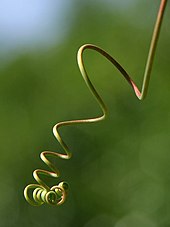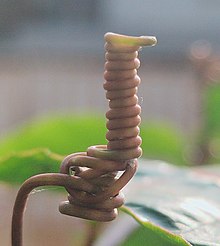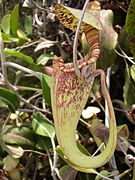Tendril

In
History
The earliest and most comprehensive study of tendrils was
Biology of tendrils
In the

The specialised pitcher traps of Nepenthes plants form on the end of tendrils. The tendrils of aerial pitchers are usually coiled in the middle. If the tendril comes into contact with an object for long enough it will usually curl around it, forming a strong anchor point for the pitcher. In this way, the tendrils help to support the growing stem of the plant.[6] Tendrils of Cuscuta, a parasitic plant, are guided by airborne chemicals, and only twine around suitable hosts.
Evolution and species
Climbing habits in plants support themselves to reach the canopy in order to receive more sunlight resources and increase the diversification in flowering plants.[7] Tendril is a plant organ that is derived from various morphological structures such as stems, leaves and inflorescences. Even though climbing habits are involved in the angiosperms, gymnosperms, and fern,[8] tendrils are often shown in angiosperms and little in fern. Based on their molecular basis of tendril development, studies showed that tendrils helical growth performance is not correlated with ontogenetic origin,[9] instead, there are multiple ontogenetic origins. 17 types tendrils have been identified by their ontogenetic origins and growth pattern, and each type of tendrils can be involved more than once within angiosperms. Common fruits and vegetables that have of tendrils includes watermelon (Citrullus lanatus)'s derived from modified stem, pea (Pisum sativum)'s derived from modified terminal leaflets and common grape vine (Vitis vinifera)'s is modified from whole inflorescence.[10]
Coiling mechanism
Circumnutation
The mechanism of tendril coiling begins with circumnutation of the tendril in which it is moving and growing in a circular oscillatory pattern around its axis.[11] Circumnutation is often defined as the first main movement of the tendril, and it serves the purpose of increasing the chance that the plant will come in contact with a support system (physical structure for the tendril to coil around).[12] In a 2019 study done by Guerra et al., it was shown that without a support stimulus, in this case a stake in the ground, the tendrils will circumnutate towards a light stimulus. After many attempts to reach a support structure, the tendril will eventually fall to the ground.[13] However, it was found that when a support stimulus is present, the tendril’s circumnutation oscillation occurs in the direction of the support stimulus. Therefore, it was concluded that tendrils are able to change the direction of their circumnutation based on the presence of a support stimulus.[13] It is important to note that the process of circumnutation in plants is not unique to tendril plants, as almost all plant species show circumnutation behaviors.[11]
Contact coiling
Self-discrimination
Although tendrils twine around hosts based on
Studies confirming this pathway have been performed on the climbing plant
Self-discrimination may confer an evolutionary advantage for climbing plants to avoid coiling around conspecific plants. This is because neighboring climbing plants do not provide as stable of structures to coil around when compared to more rigid nearby plants. Furthermore, by being able to recognize and avoid coiling around conspecific plants, the plants reduce their proximity to competition, allowing them to have access to more resources and therefore better growth.[18]
Gallery
-
Nepenthes rafflesiana upper pitcher with coiled tendril.
-
Virginia creepervine beginning tendril
-
Cucumber tendril
-
Squash vine coiled tendril
References
- ^ "Plants: A Different Perspective". content.yudu.com. Archived from the original on 2017-02-17. Retrieved 2018-01-09.
- ^ "How Plants Climb - Climbing Plants & Vines | Gardener's Supply". www.gardeners.com. Retrieved 2022-04-27.
- ^ Kurata, Shigeo (1976). Nepenthes of Mount Kinabalu. Kota Kinabalu, Malaysia: National Parks Trust. p. 47.
- ^ Kilbride Jr., Joseph H. (1993). Biosystematic Monograph of the Genus Cucumis. Bonne, No. Carolina: Parkway Publishers. p. 77.
- ^ Charles Darwin, "On the movements and habits of climbing plants", Journal of the Linnean Society, 1865.
- ^ Clarke, C.M. 1997. Nepenthes of Borneo. Natural History Publications, Kota Kinabalu.
- PMID 15451690.
- ISBN 978-1-118-39240-9, retrieved 2021-06-05
- S2CID 4860319.
- PMID 29666627.
- ^ PMID 19422543.
- S2CID 13792885.
- ^ PMID 31719580.
- PMID 21665632.
- S2CID 13792885.
- PMID 16656803.
- PMID 21628227.
- ^ PMID 26311669.
- ^ PMID 28250182.
External links
 Media related to Tendrils at Wikimedia Commons
Media related to Tendrils at Wikimedia Commons




